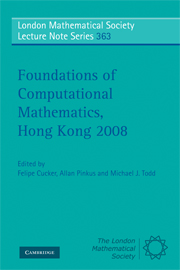Book contents
- Frontmatter
- Contents
- Preface
- Contributors
- 1 Smoothed Analysis of Condition Numbers
- 2 A World of Binomials
- 3 Linear and Nonlinear Subdivision Schemes in Geometric Modeling
- 4 Energy Preserving and Energy Stable Schemes for the Shallow Water Equations
- 5 Pathwise Convergence of Numerical Schemes for Random and Stochastic Differential Equations
- 6 Some Properties of the Global Behaviour of Conservative Low-Dimensional Systems
- 7 A Panoramic View of Asymptotics
- 8 Tractability of Multivariate Problems
6 - Some Properties of the Global Behaviour of Conservative Low-Dimensional Systems
Published online by Cambridge University Press: 07 September 2011
- Frontmatter
- Contents
- Preface
- Contributors
- 1 Smoothed Analysis of Condition Numbers
- 2 A World of Binomials
- 3 Linear and Nonlinear Subdivision Schemes in Geometric Modeling
- 4 Energy Preserving and Energy Stable Schemes for the Shallow Water Equations
- 5 Pathwise Convergence of Numerical Schemes for Random and Stochastic Differential Equations
- 6 Some Properties of the Global Behaviour of Conservative Low-Dimensional Systems
- 7 A Panoramic View of Asymptotics
- 8 Tractability of Multivariate Problems
Summary
Abstract
When studying a dynamical system from a global viewpoint, there are only few theoretical tools at our disposal. This is especially true if we want to describe all aspects of the dynamics with a reasonable amount of detail. A combination of analytic, symbolic and numerical tools, together with qualitative and topological considerations, can give a reasonably good description. Furthermore it is possible to derive paradigmatic models which can be analysed theoretically and allow us to study pieces of the dynamics. It is also important to know the relevance of different phenomena. Are they confined to a narrow domain of the phase space or to a tiny region of the parameter space or do they really play a significant role? Several theoretical/numerical tools are presented, and applied to different problems in celestial mechanics, unfolding of singularities and other problems. This is part of a project aimed towards understanding finite-dimensional systems in a global way. To avoid technicalities we shall assume that all maps and flows considered in this paper are analytic.
Introduction
Many properties are known for low-dimensional conservative systems, like Area-Preserving or Measure-Preserving Maps (APM, MPM) or systems which can be reduced to them as 2-degrees of freedom Hamiltonian systems and volume-preserving 3D flows. Most of these properties have a local character, either around a fixed point, around a given orbit, like a periodic orbit or a homoclinic orbit, or around an invariant curve or torus.
- Type
- Chapter
- Information
- Foundations of Computational Mathematics, Hong Kong 2008 , pp. 162 - 189Publisher: Cambridge University PressPrint publication year: 2009
- 2
- Cited by



